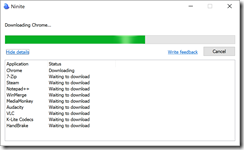A few years ago, soon after the launch of Windows 10, a long time friend of mine and somebody whose opinion I respected, announced that Windows 10 was, essentially, “rubbish”.
I had been running Windows 10 beta builds for a while and had become familiar with it, noticing several changes that were (in my opinion) a step back from Windows 8.x for touchscreen devices, but also noticing lots of improvements and potential. I had grown to like what I was seeing and so was interested in his thoughts and how he had come to this conclusion. So I asked what he didn’t like about the new OS.
I forget what his reasons were (although I do remember thinking they were misinformed) because of the one thing I do remember him saying that rendered everything else virtually irrelevant.
“How long did you use it for?” I asked.
“Oh, about 5 minutes on a display machine in PC World.” was his reply.
What?
Sorry. WHAT?!!!
I didn’t bother wasting any more time on this particular conversation with him as a big piece of me had just died.
I don’t want to make the same mistake in my notes on my move (back) to Android. After several years as a Windows Phone/Mobile user, I had grown to like the OS immensely. It seems to me that I wouldn’t be being fair if I ignored all those years of familiarity and muscle memory that I’ve built up by rushing into a review of Android. That comfortable familiarity isn’t going to vanish overnight.
So to get started, what was bad with Windows Phone?
Well, the design was excellent, by which I mean both the UI and the internals operation (I had a stab at writing some apps for my own amusement over the years). I believe the OS could (should?) have had a great future.
I never really took to the truncation of titles and text as a design element, as opposed to wrapping or overflowing the content. To me it often made distinguishing between similar text (for example “Television Programmed – Series 01 – Episode 01” where there are multiple episodes) difficult. It was certainly distinctive at the time, and the visual flair, speed and reliability were astounding, even on low end hardware.
But over the years the soul of Windows on Phone had been diluted, possibly down to circumstance. I remember the way I could have a conversation in Windows phone 7.5 using SMS, Skype and Facebook Messenger, and the conversation could be seen all in one place as if one chat (if that was what you wanted) for example. Or how brining up the details of a contact would pull in information from their social media accounts too, for example recent Twitter and Facebook posts, etc. This kind of holistic approach was either removed or watered down in later releases of the OS (why would Facebook want you to see messages from their platform without their branding attached, for example?)
Then there was the app gap. Virtually all the apps I wanted to use were available at the time, or if not a third party solution existed, that due to the excellent Microsoft developer tools available, would frequently be better than the official apps on other platforms. But as I’ve mused in the past, you don’t know you’re missing something until you’ve had it. I knew I was blissful in my ignorance of what was out there, but I was blissful just the same.
Incidentally I think if Microsoft were to add Service Workers and a couple of other PWA features into the Windows Mobile version of IE, and allow PWAs into the store for the phone, there would be a second chance of life in the platform, but time has moved on and they say that isn’t going to happen. Anyway, I digress…
So with the end of Windows Phone becoming as official as it was ever going to get, I made the jump to Android.
New hardware is almost always fun, especially when it offers something different. To this end I didn’t go for a flagship phone, but my tentative choice of the mid range Motorola G5s Plus seems to be a decent decision.
The camera isn’t terrible but a big step down from the Lumia 950XL, but I’ll take the front mounted fingerprint sensor over the iris unlock any day. The Iris unlock worked surprisingly reliably for me, but it’s just not as convenient as tapping your finger. I don’t see how you could get around this on any mobile platform. I don’t want to point my phone at my face to use it. Of course, having both options would be best, but I still feel I’d use the fingerprint more frequently.
I’m delighted to say Android itself now seems very stable. My biggest memories from my Desire HD and Motorola Xoom (tablet) days are the frequent OS crashes. Apparently no more! Individual apps still crash, but no more than I’m used to (something that I feel got worse over time with each new Windows Phone OS reboot).
I miss my live tiles, but the hunt and peck nature of Android launchers isn’t the worst thing in the world to deal with. On that note, I use the Microsoft launcher which is good, arguably offsetting the loss of live tiles with its other functionality such as the cards available on the left page.
Apps seem to be fairly decent. Not only are there obviously lots to choose from, but I had a surprising number I paid for first time around which were still in active development.
I now have too many apps to choose from. I’ve installed loads of store and loyalty cards (for example) for places I just don’t go to anymore.
I’m also now able to connect to a greater range of hardware such as fitness trackers or smart scales, without jumping through hoops (although I have encountered an incompatibility issue on this front with one particular device on my phone).
I still miss the excellent NextGen reader, but have grown accustomed to the official Feedly reader. In fact, this illustrated my initial point perfectly. I absolutely hated the Feedly reader to begin with, it just didn’t work how I did, but the alternatives were even worse for me. Now, after using it for six months I’m comfortable with it. Sure I’ve altered my workflow to fit in with it, but being pragmatic NextGen defined that workflow in the first place, so it’s not the fault of either product.
And that’s my initial point. I miss Windows Mobile, but I’m OK on Android now after giving it a fair chance, and me time to adjust.
Would I go back to Windows Mobile if it came back from the dead with a strong catalogue of apps? Possibly, but I’d be acutely aware of what I’d be giving up now that Android has matured into something more stable.





Recent Comments